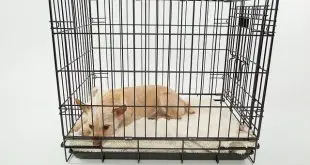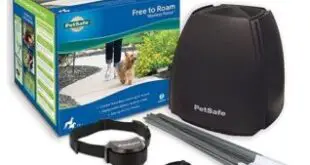This post may contain affiliate links. Please read our disclosure.
What are some of the best dog fence ideas? For pet owners, it is important to consider a few factors before deciding on what type of fencing will work for their yard.
The size and shape of your property, the age, and breed of your pet, as well as any accessibility issues these might have, are all considerations that should be made when considering different types of fences.
There are many advantages to having a dog fence installed in your yard including reducing roaming time for dogs (lessening lost or stolen chances) and protecting them from wildlife such as coyotes or wild animals like raccoons.
Dog fences also provide protection for children playing in yards by keeping pets out while still allowing them access.
Article Contents
Common Types of Dog Fences & Ideas
1. Wooden Fence
Wood fences are a classic way of containing dogs outdoors. They provide privacy, serve as additional fencing for dogs, and often just give your yard a nice look overall.
However, when looking to buy one there are many choices to be made. Do you want professional-grade items or cheaper ones?
And if you do choose wood dry living trees such as cedar or redwood will cost more than kiln dried logs.
So if budget is an issue go with the cheaper alternative of pine/fir which is still sturdy and looks great when stained without breaking the bank!
Regarding dog problems, these fences usually cannot withstand determined scratching by small breeds but can be installed in two lines of rails with reinforcing mesh.
2. Invisible Fence
The invisible fences provide a perimeter that your habituated or bored dog should not pass. Invisible dog fences transmit radio waves in order to create a sensation on the skin that is similar to being shocked by static electricity.
Fences can also be electric, such as those that charge wirelessly or over power lines. Those as well as underground and offset barriers all work well when used appropriately with the size and type of your pet!
3. Chain Link Fence
A chain-link fence is a good choice for dogs with short hair. Dogs with long fur are likely to get caught in the links, which would get tangled and prevent them from climbing out of the fence.
Chain link fences come in all shapes, sizes, and styles causing it to be difficult to find one that’s perfect for you.

Here are a few criteria that may help you save time when looking for fences for your home or yard: material, style of gate, height requirement (~7 feet), type of dog (short hair-chain link; medium length-vinyl coated wire mesh or plain wire mesh; long hair-plastic over chain link)
4. Wireless Fence
These fences include a wireless transmitter that sends electric volts through the dog’s collar to keep it in the yard. they work similar to the underground (in-ground or invisible) fences, only that in this case no wire is involved.
Instead, the dogs are fitted with GPS Collars.
If you have free reign over your backyard but don’t want to invest in extensive fencing, then you might consider getting a wireless fence from pet containment systems or Innotek.
These fences create boundaries where dogs can roam around at will without ever crossing into areas covered by electricity.
Wireless fences also come with adjustable levels of electric voltage ranging from minimal buzzing noise (soothing to humans
5. Picket Fence
A picket fence is a type of fence that has vertical posts held together with perpendicular lines of horizontal boards.
Picket fences were historically used to keep livestock from entering private property, and the style became common for residential construction around the same time.
Picket fences can therefore be used to restrain the small dog breeds effectively, but do not work well with large or active dogs.
For instance, medium- and large-sized dogs such as golden retrievers, labs, or boxers cannot be contained using picket fences because they would simply jump over them.
The technique or manufacturing process is called “picketing”. This term comes from ‘piquer’ which means to prick.
The steel rod is heated in a forge until it’s cherry red and then driven through a series of slots cut horizontally into wedges or slats of wood.
Once cool, the rod draws these tight against each other to form a sturdy barrier for people or animals to keep out and also acts as reinforcement under tension when pressure is applied from outside.
6. Snow Fence
A snow fence, also called a snow berm, is a barrier used in hilly terrain to slow or stop the flow of deep snowdrifts. They also have the purpose of preventing avalanches from more populated regions.
However, they can also be used to restrain dogs within the yard.
Snow fences generally consist of heavy hexagonal press-board fencing panels that are erected perpendicular to the slope at regular intervals and held down by wire hoops anchored into posts set at even distances along their length on level ground.
Snow deposits collect against these boards forming an artificial terrace with a gentle incline running from bottom to top (cross-section).
The posts may be driven into the ground for maximum stability but most often they are attached at intervals by cable and pulley so as not to impede traffic during construction.
The disadvantage of using the snow fence for dogs is the fact that they are not durable. In fact, this is probably the reason they are categorized as part of the temporary dog fences.
7. Split Rail Fence
One of the simplest fences to contain your dog is a split rail fence, with boards spaced about ten inches apart.
This type is most often used for boundary fencing (such as keeping cattle off the road). A narrow corral may be substituted, but that’s more expensive and takes longer to build.
For dogs, a split rail fence with welded wire is excellent.
It keeps your pet pals secure while retaining the timeless charm of split rail fencing. Split rail fencing, unlike electronic fencing, is unaffected by power outages, battery troubles, or broken wires, and it does not jolt your best companion.
8. Indoor Dog Fence
An indoor dog fence can provide a safe and secure yard for the pet.
The indoor dog fences perfect for dogs that don’t get to go on walks an excessive amount because they have health issues, or if there’s a tenant in your house who doesn’t support having pets in the home – this will give them much more freedom without being at risk of escape.
In order to install an indoor fence for dogs, the electricity company must be notified that there is a coil and wire installed which may disrupt any type of wireless service.
This service interruption should not last long as all you are doing is turning off power to one room for about thirty minutes!
9. Portable Dog Fence
Portable dog fences, as the same suggests are dog restraints that can be easily moved from one place to another. they are suitable for travelers or campers who wish to move with their dogs to new places regularly.
Consider portable dog fences as easy-to-construct play areas for dogs when camping.
Conclusion
The fence you choose can be determined by your budget, the space that needs to be enclosed, and style preferences. You may also want to consider what kind of materials will hold up in different weather conditions such as snow or rain.
If you are still unsure about which type of fencing is best for you, consider checking our reviews of the best dog fences to find options that suit your needs.
 Petnile Comprehensive Pet Care Guides
Petnile Comprehensive Pet Care Guides

